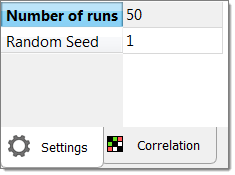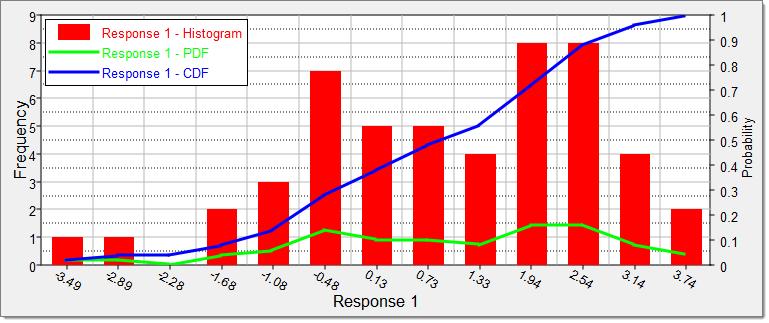This tutorial demonstrates how to run a stochastic study on simple functions defined using a Templex template.
The base input template defines two input variables, DV1 and DV2, labeled X and Y, respectively. The objective of the study is to investigate the two random variables X, Y forming the two functions X+Y and 1/X + 1/Y – 2.
Before running this tutorial, you must complete tutorial Simple Optimization Study - HS-1710 or you can import the archive file HS-1710.hstx, available in <hst.zip>/HS-1715/.
| 1. | In the Explorer, right-click and select Add Approach from the context menu. |
| 2. | In the HyperStudy - Add dialog, select Stochastic and click OK. |
| 3. | Go to the Specifications step. |
| 4. | In the work area, set the Mode to Latin Hypercube. |
| 5. | In the Settings tab, change the Number of runs to 50. |

| 7. | Go to the Evaluate step. |
| 8. | Click Evaluate Tasks. HyperStudy executes 50 runs and extracts the results. |
| 9. | Go to the Post processing step. |
|
In the Post processing step of a Stochastic approach, you can access additional tools to review results.
| 1. | Click the Distribution tab. |
| 2. | Using the Channel selector, select Response 1. |

| 3. | Click the Reliability tab. |
| 5. | In the HyperStudy - Add dialog, add two reliabilities. |
| a. | Set Response to Response1 (r_1). |
| b. | Set Bound Type to <= (less than or equal to). |
| a. | Set Response to Response2 (r_2). |
| b. | Set Bound Type to <= (less than or equal to). |
| 8. | Study the effects of bounds on the reliability by entering different values in the Bound Value column. |
| • | For reliability 1, enter 1.050. The reliability value of Response_1 to be less than 1.05 is 48%. |
| • | For reliability 2, enter 1.830. The reliability value of Response_2 to be less than ... is ...%. |

|
See Also:
HyperStudy Tutorials







